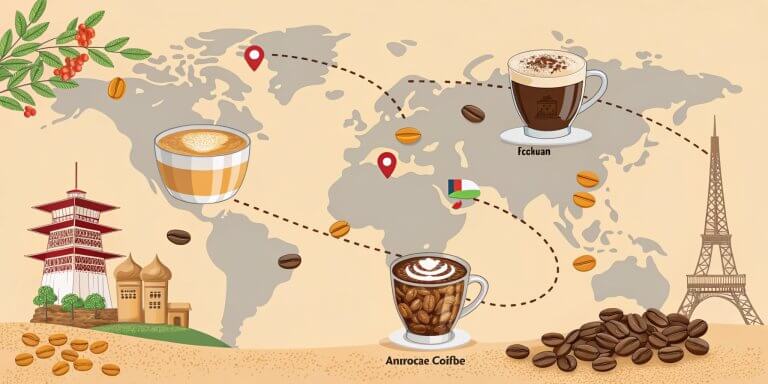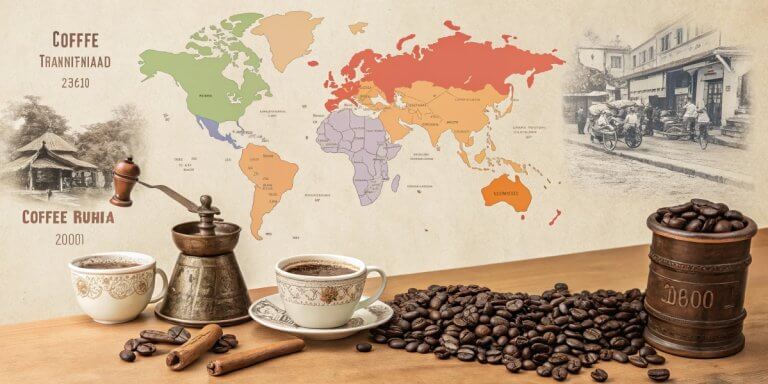
Coffee is more than a daily habit. It shows us different tastes and cultures. Every cup tells a story from where it grows. Ethiopian beans taste fruity like wine. Indonesian beans taste earthy. This guide will show how land, weather, and soil make each coffee taste special.
The Role of Geography in Coffee Flavors
Coffee flavor comes from its home. High places give beans a firmer texture and more taste. Rain and warmth change sweetness and zing. Soil, especially volcanic soil, adds special notes.
Coffee comes in two main types: Arabica and Robusta. Arabica grows high and tastes mild and complex. Robusta grows low and tastes strong and bitter. As we visit each region, you will see how these types, plus land and weather, shape flavor.
Africa: The Birthplace of Coffee
Ethiopia: The Legendary Origin of Coffee
Ethiopia is where coffee began. Its flavors are bright and fruity, with floral notes.
Kenya: Bright, Bold Coffees
Kenyan coffee is sharp and fruity, with berry notes and lively zing.
Tanzania: The Unique Peaberry
Tanzania’s peaberry beans are round and packed with flavor. They taste bright and fruity.
Central and South America: Smooth, Balanced Coffees
Colombia: Mild and Well-Balanced
Colombian coffee is even and sweet, with nut and chocolate hints.
Brazil: The Coffee Powerhouse
Brazil grows a third of the world’s coffee. Its beans are smooth, with nut and chocolate tones.
- Flavor: Chocolate and nut, low zing, creamy body
- Varieties: Bourbon, Mundo Novo
Costa Rica: Bright, Clean Coffees
Costa Rica focuses on quality and green farming. Its beans are bright and fruity.
Guatemala: Complex and Full-Bodied
Guatemala’s volcanic soil gives its coffee spice, fruit, and chocolate notes.
Asia: Diverse, Unique Coffee Landscapes
Indonesia: Earthy and Full-Bodied
Islands like Sumatra, Java, and Sulawesi grow earthy, smoky beans with low zing.
Vietnam: Robusta Leader
Vietnam grows most of the world’s Robusta. It tastes strong and heavy, and is often mixed into blends or served with sweet milk.
India: Spicy and Nutty
India’s coffee, especially Monsooned Malabar, is air-dried in storms to add unique flavor.
The Middle East: Traditional Coffee Culture
Yemen: Rich and Historic
Yemeni coffee, known as Mocha, has deep chocolate and wine-like notes.
Middle Eastern Coffee Traditions
Methods like Turkish and Arabic coffee focus on social rituals and shared moments.
The Pacific: Unique Island Coffees
Hawaii: Premium Kona Coffee
Kona coffee from Hawaii is mild, sweet, and floral.
Papua New Guinea: Exotic and Complex
High-altitude farms in PNG make fruity, herbal coffees with bright zing.
Specialty Coffee Movements and Their Impact
The third-wave coffee movement values single-origin beans and direct trade. People want to know where their coffee comes from and buy beans that help farmers and the planet.
Challenges Faced by Coffee Farmers
Many farmers struggle with changing weather and low pay. Fair Trade and other programs aim to give them steady income and protect the land.
Conclusion
Coffee’s journey from farm to cup is shaped by land, weather, and care. From Africa’s bright beans to Asia’s earthy roasts, each region offers a taste story. By choosing beans that support farmers and the earth, you make every sip even more meaningful. Enjoy your next cup with the tale of its origin in mind.






